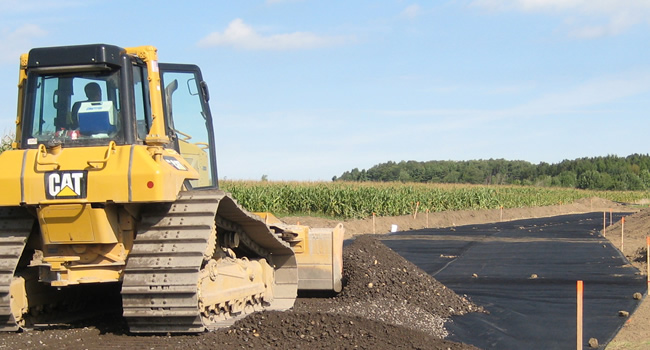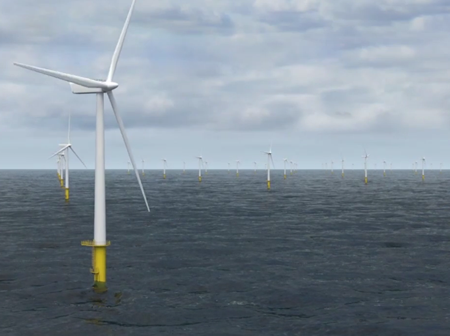The old saying “Out of sight, out of mind” applies to a lot of geotechnical work. The materials that provide the essential support to roadways, retaining walls, embankments, etc. are not in the public eye. Why things work is not the story–outside of engineering and construction, that is.
In regards to wind energy, the state of subsidies and national energy policies garner the headlines (as do unsupported assertions that the noise of wind turbines could cause cancer). Within the sector itself, those who design and develop these sites know that few of them can be developed without geosynthetic soil reinforcement technologies. Geosynthetics provide the stable base for construction works and long-term access on wind energy sites.
The reinforcement is necessary. On-shore wind turbine hub heights increasingly crest 100m. In Germany, they’ve achieved hub heights beyond 150m. Rotor diameters regularly exceed 125m on new turbines. While many turbines are still in the 3 MW range, large turbines are seeing 7 – 8+ MW. GE has developed a turbine with a 12 MW output and a 220m rotor diameter (!!).
Hub heights for on-shore towers are essentially twice as tall as just 10 years ago and the energy output is more than 4 times greater.
Off-shore turbines, which are the subject of huge interest now, are being designed even larger.
For on-shore applications, supporting the enormous weight of a turbine (more than 200 tons) frequently requires geosynthetics, especially during the construction of wind farms (e.g., cranes and working pads).
REINFORCING WIND ENERGY
Wind farms require space, of course, and it is certainly not uncommon for the soils on these more remote sites to require stabilization technologies in order to support high loads. The larger the wind farm array, the more roadways will need to be constructed between the turbines. Miles of road may be needed on a utility-scale site. These are almost exclusively unpaved roads too, so soil reinforcement and stabilization is a welcomed strategy for ensuring dependable access for heavy vehicle traffic.

Efficiency is stressed in these road networks. A developer wants to minimize the amount of roadway to be constructed while also minimizing the need to use public roads.
On an optimally designed site, crews will not need to “leave” a site to transition from one turbine’s work to assemble the next in the array. They want to move cranes and other key equipment from one pad to the next without technically exiting the site. The large loads involved may require special permitting or equipment disassembly, in the event of needing to transport equipment across a public road.
Crane axles, for example, must carry loads in excess of 200,000 lb.—not exactly what conventional roads are rated for.
Furthermore, the efficiency and cost control of the on-site roads will depend on minimizing land disturbance and preventing road or operational safety problems, such as rutting. Hence, geosynthetic reinforcement is utilized to stabilize the subgrade sooner, which reduces the amount of soil needed to be excavated and replaced in road construction.
WIND ENERGY EXAMPLES WITH GEOSYNTHETICS
Geogrids and high-strength geotextiles provide enormous benefit to wind farm road and crane pad construction. They increase subgrade and flexural stiffness. They reduce vertical and shear stresses. They minimize or prevent migration of fines, reduce aggregate need, and minimize excavation.
All of these benefits not only make wind energy sites more economical but in many situations simply possible.
Examples of this utility are numerous and able to be found throughout the world’s wind energy infrastructure.

HUESKER’s geogrids have been used in a number of wind energy applications. New York’s High Sheldon Wind Farm, for example, produces roughly 115 MW of power to support 60,000+ homes. The turbines have largely been installed on active agricultural lands, providing side income for those operations while taking advantage of the elevated terrain at those locations to harness the area’s strongest winds. This provides greater output and facilitates efficient delivery of power to the town.
The construction site loads in New York were around 5000 psf, making geosynthetics a must. The 17-ft.-wide rolls helped expedite construction by reducing the need to cut from additional rolls to reach the necessary width.
(Interesting sidenote on the Sheldon project: Revenue from the wind farm enabled the town to issue residents an annual tax bill of $0 from 2009 – 2016, since energy revenue met all local expenses.)
NAUE has excelled in wind farm constructions internationally with composite reinforcement solutions like Combigrid®, which embeds a durable nonwoven geotextile within a high-strength Secugrid® geogrid. This delivers soil separation, filtration, and reinforcement characteristics in a single roll. As a geotechnical solution, it provides multiple layers of road subgrade stability in a single layer for quick, substantial ground improvement.
The company has also been involved in geosynthetic-based scour protection for major off-shore wind turbine installations. Watch a descriptive video of this application here.

TenCate’s high-strength reinforcement geosynthetics (e.g., Mirafi® RSi) have been used to enable construction of wind farms internationally, including what was at the time of its installation the Netherlands’ tallest turbine: a 280-ton, 135m tall (hub height), 7.5 MW Enercon E-126. The tip height of the blade brings its size to 198m.
Without the use of the geosynthetic reinforcement, it would not have been economically feasible to construct the crane pad that was needed to support the construction works.
The feature photo on this article, in fact, comes from a wind farm installation that utilizes TenCate reinforcement materials.
GREATER SUSTAINABILITY IN CONSTRUCTION
The sustainability benefits of wind energy rest not just in the renewability of the energy source. Geosynthetic reinforcement, in strengthening soil more efficiently, requires less land disturbance than would be required to build wind farms without reinforcement. Significantly less soil must be carved into to achieve the appropriate access road and construction platform bearing strength when geosynthetic layers are included. Aggregate fill may be reduced by up to 40%, and over the course of acres of infrastructure this represents substantial time, energy, and cost savings in construction.
The carbon footprint of the on-site construction is greatly reduced, as is the transport to the site of heavy aggregate in polluting trucks.
By reinforcing soils efficiently, wind farms are built faster, more economically, and with a lower carbon footprint.
WIND ENERGY RESOURCES
American Wind Energy Association: www.awea.org
Canada Wind Energy Association: www.canwea.ca
European Wind Energy Association: www.ewea.org
Global Wind Energy Council: www.gwec.net












good application , however economic advantage purely depends upon the cost of locally available material